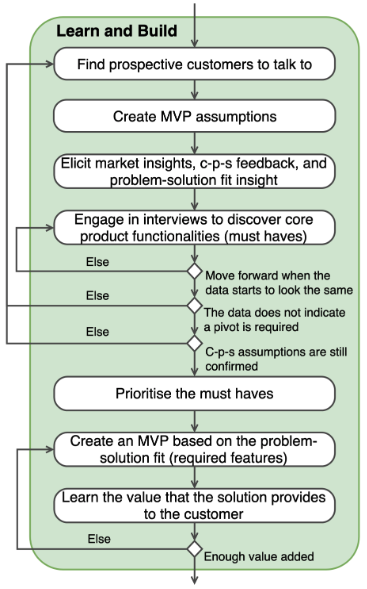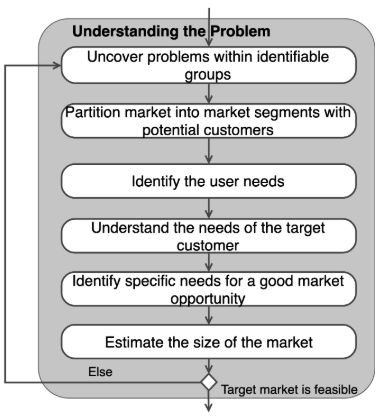Software startups around the world are struggling to survive. Usually, within two years from the startups’ creation, it is not competition but rather self-destruction that drives the majority of startups into failure. My previous post presented a go-to-market approach based on The Lean Startup, Design Thinking, The Lean Product Playbook, and The Startup Owner’s Manual, to provide structured guidance to startups. These strategies are all user-driven innovation strategies: they involve potential users, customers, or other stakeholders into the development process, thus maintaining a user-centred approach. In this article, I want to explain what has proven to be the most crucial part of the software startup: finding the problem-solution fit. The aim of this fit is to implement a solution that tests the trickiest hypotheses of the customer problem. The solution is based on a real customer problem that contains a particular need. If the hypotheses hold and the solution thus solves the customer problem, the problem-solution fit has been found.
In this (and the next) article, I report the main findings of the research and discuss some parts of the Process Diagram, which is based on Method Engineering. The phases that I discuss are shown in the figure above: Learn and build, Understanding the problem, Create a customer point of view, Ideate, and Discover customers. This diagram has been evaluated by twelve co-founders of successful software startups in a holistic multiple-case study. We found that these founders all used a structured approach to building their startup. Therefore, we hypothesise that software startups can benefit significantly from a practical startup approach. Next, we dive deeper into the Learn and Build phase, which is the most crucial phase software startups go through.
“New products are inherently hard to launch because both the problem and solution are unknown.” - Eric Ries
Learn & Build
This Learn and Build phase (shown in the figure below) has proven to be the most important, parallel phase that successful startups follow. It contains the very first activity that startups should follow if they have an idea: Find prospective customers to talk to. Usually, this idea is already translated to a software product, which should always be a Minimum Viable Product (MVP): a version of the product that requires the least amount of development time with a minimum amount of effort.

Each startup that was interviewed acknowledged the importance of working with an MVP. One of the startups stated the following: “We do create MVPs now, but we did not back then. That is one of the very valuable lessons we have learnt.” An MVP is based on requirements desired by potential customers, but to obtain these requirements, the startup should talk as early as possible with those customers. The startup then requires to prioritise the ‘must haves’, which are the minimum necessary requirements for the MVP. Once the MVP is ready for customer feedback, the second most important activity is performed by the startup: Learn the value that the solution provides to the customer. Actively learning about the value the solution provides and eliminating every non-value-creating effort (‘waste’) in the product, results in validated learning: an empirical procedure of measuring progress concerning the present and future business prospects. It is invaluable that a startup actively learns and build, in a constant feedback loop with the (potential) customer. As one co-founder puts it: “We still do this, every day.”
“No facts exist inside the building, only opinions.” - Steve Blank
Understanding the Problem
The title explains exactly what this phase (shown in the figure below) is for: understanding the customer problem. Many startups start developing customer solutions without considering the customer problem. This problem should reside within identifiable customer groups. During the case studies, we found that partitioning the market into market segments with potential customers was an important activity, however: this is something that can be changed in a later stage because sometimes you find your best market segment when you first attract some customers.”. And you do not always have the time and resources to identify problems in every segment. Co-founders also approached people that were “daring” enough to try their solution. Nonetheless, it is wise to reconsider your ‘best’ customer segment when the startup is in a later phase, having attracted several customers. Estimating your market size is also important and sometimes overlooked by startups. If the market is too small, the startup, operating costs, and capital are not covered by the potential sales. However, as one of the case participants put it: “This is not rocket science, measure the size relative to the startup, but do this quickly.”

This phase does dig to the core of finding the problem-solution fit, which is encountering the customer problem. During the case studies, interesting results were found regarding finding this problem. Almost every co-founder encountered the problem himself by working in a specific domain where the problem occurred. One of the case participants worked as a lawyer where he encountered problems regarding time writing in the legal profession. Another founder worked in the e-commerce space, where he observed a missing solution for ordering online groceries. Most founders worked as a consultant where they observed a problem during a consultancy project. They observed that companies were either not solving the problem or “handling it incorrectly”, which “triggered” the founders into building a prospective business that solves that problem. This suggests that if you have a desire to start a company and are working in a certain domain, a customer problem might be closer than you think. In other cases, the founders could stumble upon the customer problems in their personal life by accident or by, as they described it, “sheer luck”.
Chronologically, the next phases are ‘Create a customer point of view’, ‘Ideate’, and ‘Discover customers’. However, during the case studies, these proved to be largely optional phases, as some startups understood the customer problem well enough to proceed and discover customers right away.
“A key understanding of the problem that you solve, and why it must be solved, that is 80% of the process.” - Case participant
Concluding
If a startup went through the ‘Learn and build’ phase with properly ‘Understanding the customer problem’, the customer problem is clearly mapped. This is true because the MVP has been constructed in a constant, parallel process, together with the customer. The startup then actively applies validated learning from the customer feedback and implements that in the solution. By ensuring that the solution fits the customer problem, the chance of finding the problem-solution fit is high. The next step for the startup, which will be explained in the next article, is finding the product-market fit.
